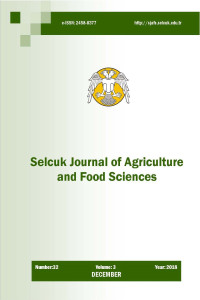Abstract
Dünya bağcılığında önemli bir yere sahip olan ülkemiz bağcılığı tarihsel bir geçmişe sahiptir. Türkiye asmanın anavatanı olarak kabul edilmektedir. Anadolu’da binlerce yıldır yapılan yetiştiricilik çok büyük asma form zenginliğini doğurmuştur. Ülkemizde son yıllara kadar çoğu yöresel çeşit olan 1400’ün üzerinde üzüm çeşidinin yetiştirildiği belirlenmiştir. Bu çeşit zenginliğini kaybetmemek için gerekli koruma çalışmalarının gerçekleştirildiğini söylemek oldukça güçtür. Bu nedenle asmada bu çeşit zenginliği azalmaya yüz tutmuştur. Genetik kaynaklarımız başkalarının elinde altın değeri kazanmış, dünyaya yayılmıştır. Birçok çeşidimiz bizim tarafımızdan sahiplenilmediği için sahipsiz kalmıştır. Dünya bağcılığında ‘Thompson Seedless’ adı altında önemli bir yere sahip olan ‘Sultani Çekirdeksiz’ çeşidimiz bu sahipsizliğe verilebilecek en güzel örnek olarak karşımıza çıkmaktadır. Bu makalede üzümün tarihine kısa bir bakıştan sonra genetik kaynaklarımızın durumu gözden geçirilmiştir.
Abstract
The vineyard culture and also the historical background of Turkey has an importance in the world. Turkey is one of the motherland of grape. Because of the grape growing for hundred years in Anatolia, a large grape variation was obtained in this area. It is determined that, there are more than 1400 grape varieties were growing in Turkey until very recently. And all of them are genetic resources of our country. It is difficult to say that we are doing the necessary protection studies. Because of this, richness of grape variety is getting lost day by day. On the other hand, our grape biodiversity has an important value in the other countries hands. Our major grape varieties are spread all over the world without our control. However, many of our grape varieties remained unclaimed because of our disclaimed. An important sample of this is Thompson Seedless. In fact, the true name of Thompson Seedless is ‘Sultani Çekirdeksiz’ and it is our genetic resource. But, it is known as ‘Thompson Seedless’ by the entire world. The actual situation of our grape biodiversity has been revised after a short brief of grape history. At the end of the article, we made some recommendation for protecting our grape biodiversity.
Details
| Primary Language | English |
|---|---|
| Subjects | Horticultural Production |
| Journal Section | Review Articles |
| Authors | |
| Publication Date | December 28, 2018 |
| Submission Date | May 9, 2017 |
| Published in Issue | Year 2018 Volume: 32 Issue: 3 |
Selcuk Agricultural and Food Sciences is licensed under a Creative Commons Attribution-NonCommercial 4.0 International License (CC BY NC).


